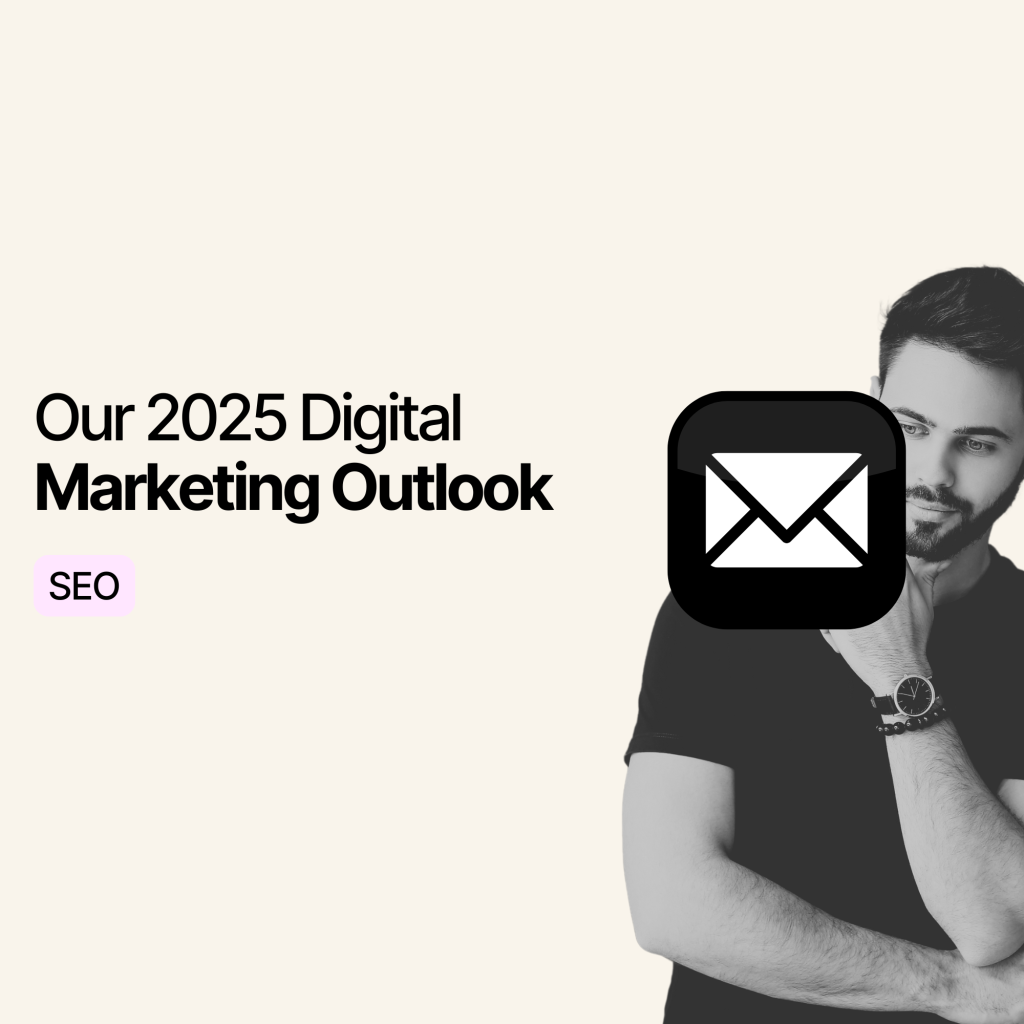As the calendar turns to 2025, digital marketing practices are poised for another significant shift. Fresh technologies, emerging platforms, and changing audience habits are shaping the next wave of growth. To better anticipate what’s ahead, we’d like to share our thoughts on trends to watch, approaches that promise stronger returns, and tools set to make an impact. We’ll also weigh in on tactics best left behind in 2024, the biggest challenge waiting around the corner, and the sectors that stand to gain the most from refining their digital efforts. We’ve split this up into general digital marketing thoughts and then gone into more detail in our specialist areas of SEO, CRO and Paid marketing.
Top 2025 Digital Marketing Questions to Consider
What trends do you expect to see in 2025?
What strategy or tactic do you envision will have the biggest impact on ROI this year?
What strategy or tactics should we leave in 2024?
What new tools or software are you looking forward to using in 2025?
What do you think will be the biggest challenge in 2025?
What industry or sector could most benefit from upping their digital practices in 2025?
eCommerce 2025 Outlook
A few key trends we foresee for digital marketing in 2025, in no particular order:
Loyalty-driven strategies – It’s time for us all to have a comprehensive rethink on how, as businesses, we create value, moving from a transaction-first approach to more relationship-focused models. This will help to push repeat business and improve brand loyalty.
Privacy and trust as competitive advantages – With consumers increasingly wary of how their data is stored and used, retailers that respect their customer’s preferences will build stronger, more loyal relationships. We’d like to give a special nod to Germany whose digital policies seem to be leading the way on this.
Ethical personalisation – Retailers will need to be increasingly transparent about how they use data and ensure they allow customers to opt in or out meaningfully.
AI Shopping Agents – We suggest you start to build a plan for AI and insights-driven technologies now. The prevalence of this technology will only continue to grow and seep its way into various aspects of the purchase journey. Start small, iterate, and learn. This will soon become the expected ‘norm’.
Something we firmly believe that should be left in 2024 is the practice of retailers discounting themselves into oblivion. Yes, sales and discounts can drive quick wins, but overusing them trains your customers to never expect to pay full price. You’re eroding your margins AND your brand. Work more on building value – better products, better experiences, and better reasons for people to come back.
Secondly, not so much something to leave behind but something we think could vastly be improved upon. If you’ve not got a good handle on your data – and by that we mean accurate data tracking which you can rely on and interpret in a meaningful way – now’s the time to act. We still see businesses doing this – making gut-feel decisions with zero data to back them up. If you’re not digging into your numbers; such as Lifetime Value, Cost Per Acquisition and the most important of them all, profitability – then you’re guessing. And guessing isn’t a strategy. Unify your data, look at the big picture, and make decisions based on what’s working.
As an agency with its roots in experimenting to optimise digital experiences, I’m excited about the advancements in A/B Testing platforms. Expect more accessible platforms that integrate seamlessly with your eCommerce stack (special shout out to one of our Partners and a genuinely brilliant testing tool, Mida.so) offering not just A/B testing insights but more ways to personalise experiences without draining your time (or budget).
Also, further to the point above about using data more wisely to track true profitably, there are some brilliant tools like StoreHero that unify sales, ad spending, and operational costs. Imagine knowing exactly how profitable you are on a campaign or product right now. No more excuses for flying blind.
When considering what challenges we are likely to face in 2025, if we ignore the economy, then number one is probably keeping up with ever-demanding customer expectations. Faster delivery, smoother checkout, and personalised experiences aren’t “nice-to-haves” anymore – they’re baseline. If you’re not meeting these expectations, someone else will, and they’ll happily take your customers while they’re at it.
And as always, maintaining focus. There’s a lot of noise around AI and shiny new things that can easily distract you from what’s important. The businesses that focus on efficiency, customer value, and data-driven decisions will be the ones that win. It’s the survival of the smartest in 2025.

SEO 2025 Outlook
Every single year, SEO is proclaimed as dying, but we firmly believe this is a huge misjudgment – SEO doesn’t die, it evolves. How we create and set up websites changes to the tune of browser behaviour. Here are some SEO trends for 2025 that you should keep an eye on.
More AI in Search: AI-driven tools and generative search engines are transforming how users discover content. Platforms like ChatGPT, Gemini, or Perplexity are becoming more significant traffic sources. This means you need to track traffic and revenue from AI-driven tools, ensure these tools can crawl your sites correctly (technical SEO is important), and consider “Generative Engine Optimisation” (GEO) as part of your SEO strategy. This also means that the search landscape is changing: more 0 clicks results which means higher impressions but no clicks (though Google has started to add more links to sources), AIO pushes all results including ads further down in search. AIO could maybe replace featured snippets one day. Start using the correct schema markup to show up for more personalised results for each user.
The Rise of First-Hand User Experience (and more EEAT): With an increase in AI-generated content, authenticity and expertise are more critical than ever. Google now gives more visibility to platforms like Reddit, Quora, and niche forums that showcase real human insights. To make the most of this you should focus on EEAT, create unique, value-driven content that users can’t find elsewhere and where possible use relevant leverage UGC through reviews, comments, and community discussions.
High-Quality and Multi-Format Content: Prioritise quality over quantity, with a focus on multi-format content to meet diverse user needs. Repurpose content across channels. Test various formats to see what works: videos, podcasts, webinars…and then repurpose this content on your blog, newsletter, and social media. Make your content work harder than ever before. Cross-team communication is key, ensuring SEO doesn’t work in a silo and is integrated with other marketing channels is imperative.
User Experience (UX) and Intent-Driven Search: SEO in 2025 is more about intent-driven strategies than keyword research. Search engines reward content that addresses user questions comprehensively and aligns with search intent. Use search features such as PPA to refine your content, monitor SERPs for any significant changes, and provide good UX, CWV and crawlability.

CRO 2025 Outlook
CRO, by definition, encourages you to be on the cutting edge of eCommerce. Repeatedly pushing your website to provide the best experience for your visitors measurably and tactically. We applaud anyone giving CRO a go and have some thoughts on the things to look out for in CRO in 2025.
AI-Powered CRO and Predictive Analytics: AI-based methods are set to take centre stage in 2025, with predictive analytics forecasting user actions more precisely than ever. Machine learning systems will scan large data sets to pinpoint patterns, highlight winning page designs, and streamline testing. By removing much of the guesswork and manual trial-and-error, this approach offers a stronger path to boosting conversions in a fast-changing market.
Hyper-Personalisation and Dynamic Content: Generic, one-size-fits-all experiences will continue to decline as they become an outdated way of providing a user experience. AI-powered personalisation will allow brands to dynamically adjust their web content, CTAs, and offers based on real-time user behaviour, demographics, and intent signals.
Privacy-First CRO Strategies: As privacy regulations become even more stringent, CRO teams will need to adjust their strategies to stay ahead of the curve. Watching cookies become increasingly restricted, you’ll need to lean on first-party data – information directly gathered from customer interactions on their websites – creating stronger and more trustworthy connections. By combining this data with advanced behavioural modelling techniques, businesses can now better understand their website visitors’ preferences, likely behaviours, and needs, without relying on third-party sources.
Add artificial intelligence to the mix, and you can predict the customer journey with heightened accuracy, recommending tailored experiences in real time. This shift not only ensures compliance but also enables smarter, more personalised optimisation strategies, giving you a competitive advantage while respecting user privacy. By embracing a privacy-first approach, companies can foster loyalty and provide high-quality experiences that convert, all while maintaining transparency and trust with their target audience.
Customer-centric approach: Many companies are devoting more resources to truly grasp their customers’ motivations. Through surveys, direct feedback, and on-site behaviour analysis, they gain a clearer view of consumer preferences and pain points. These findings guide refinements in everything from website layouts to email campaigns, ensuring each channel is a closer match to customer needs. By placing people at the heart of every choice you make, you can build stronger relationships and see higher returns across the board.
CRO in 2025 will be AI-driven, privacy-conscious, and hyper-personalised. Businesses that adopt these trends early will gain a competitive advantage and see the highest ROI.

Paid 2025 Outlook
Paid marketing moves fast, with new channels and methods challenging marketers to keep up. Budgets need smart planning and strategies that adapt quickly to shifting trends. Here are the approaches we believe are set to make waves in 2025, sparking fresh opportunities for any brand looking to stand out.
AI-Driven Ad Campaigns Will Dominate: AI tools will play an even more significant role in campaign management, automating everything from keyword research to ad copy. Campaign types such as Google’s Performance Max (PMax) will continue to improve and will become even more refined, allowing brands to scale their campaigns with reduced manual input. Instead of focusing on individual keywords only, advertisers will focus on AI-led intent signals, audience behaviour, and predictive analytics. This will happen while machine learning algorithms will dynamically adjust bids, placements, and creatives in real-time to drive performance.
Smarter Use of Generative AI for Ad Copy & Creative: Ad creation tools will continue to improve, and will allow advertisers to generate compelling ad copy, responsive search ads (RSAs), and even video generation (which was not particularly impressive until very recently) will become better and allow the creation of content at scale. These tools will use real-time performance data to continuously refine messaging, delivering higher engagement and conversion rates. However, our warning to you is that businesses must ensure AI-generated content aligns with their brand voice and doesn’t compromise authenticity. Human oversight will still be essential for defining the overall strategy, and aligning optimisation with brand goals.
Data, Data and More Data: With third-party cookies being phased out, advertisers will have to rely heavily on first-party data collected through CRM integrations, email lists, and website interactions. Google’s Privacy Sandbox and server-side tracking will become standard, driving the shift away from traditional cookie-based tracking. Brands will need to enhance their data collection strategies, ensuring they can still personalise ads while remaining compliant with GDPR and other local regulations. Customer Match, enhanced conversions, and AI-powered attribution models will be critical for maintaining accurate audience targeting.
We predict that Paid Search in 2025 will be AI-driven first, privacy-first, and deeply dependent on the quality of the advertiser’s first-party data. The brands that thrive will be those that embrace automation, focus on intent-driven advertising, and adapt to evolving privacy regulations.

How are you approaching your 2025 digital marketing?
Looking ahead, 2025 digital marketing could be a game-changer for your business, with fresh AI tools, privacy-focused approaches, and loyalty-building methods on the rise. If you’d like guidance on making these shifts work for you, our team is here to help. Whether it’s SEO, CRO, or paid campaigns, we focus on practical steps that fit your goals and your customers’ needs. Send us a message, and let’s plan how to strengthen your online presence in the year ahead.
About the author
Henry Jones
Share this post
Read more

